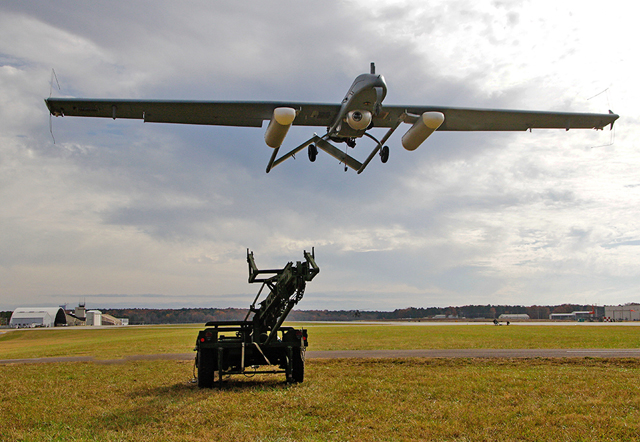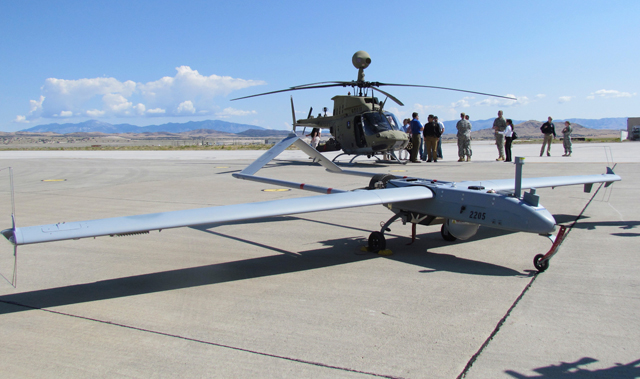It is 2018, and an enemy of the US Army seems to be having a lucky day. Yes, an unarmed unmanned air vehicle flying overhead has spotted this particular target, but the army has already retired its fleet of armed scout helicopters and the Boeing AH-64E Apache is still parked at the base with only is auxiliary power unit running.
But there is a solution. The front-seater in the AH-64E is patched into the UAV control system. If the target moves, the AH-64E crewmember can reposition the UAV to follow it as his own helicopter gets airborne. The AH-64E then flies within firing range of its 4nm (8km)-range Lockheed Martin AGM-114 Hellfire missile. That seemingly lucky target is wiped out and the AH-64 has never been exposed to any harm.
That is, anyway, the ideal scenario army officials have developed as they have started to retire the Bell Helicopter OH-58D Kiowa Warrior fleet with no direct replacement. The army instead will rely on teaming two UAV fleets – the AAI Corp RQ-7B Shadow and General Atomics Aeronautical Systems MQ-1C Gray Eagle – with the AH-64E to perform the armed scout mission.

The service operates 408 RQ-7 Shadow UAVs
US Army
As that decision moves closer to operational reality, the army is still getting to grips with the extended consequences of that decision.
The past 15 years has witnessed the rise of a vast unmanned aviation corps within the US Army, with an inventory filled with nearly 7,000 small unmanned air systems, 408 RQ-7 Shadow systems now and growing to 152 MQ-1C systems by FY2019. After more than a decade of steady acquisition, the army is left with an increasingly capable but non-integrated force of unmanned aircraft dedicated almost exclusively to the intelligence, surveillance and reconnaissance mission.
“We’re kind of at that tipping point where unmanned systems were a niche capability to a niche group of people,” says Col Thomas von Eschenbach, the UAS capability manager for the army’s Training and Doctrine Command.
The army cannot afford to keep its unmanned aviation branch so segregated any more. It also has an opportunity over the next five years. There is only one potential acquisition programme on the horizon and that is for a short-range, micro-UAS smaller than an AeroVironment RQ-11 Raven. That leaves the army’s unmanned aviation community largely available to focus on improving the systems they already have.
“We spent the last 15 years building capability. We bought a lot of stuff. It was what the market presented. It was what we needed, and we did a great job,” von Eschenbach says. “Now we have to focus on building capability.”
For years, army officials have discussed opening new mission areas to UAS buying intelligence, surveillance and reconnaissance and target acquisition. Service officials have mentioned electronic warfare as an opportunity, along with autonomous cargo delivery. The service’s declining budgets – the army aviation top line has declined by 40% since FY2012 – have largely postponed those opportunities.
Instead, the capability the army must develop rapidly is the concept of manned-unmanned teaming – also known within the army by the acronym MUM-T.
The army had always planned to pair UAVs with its helicopters, but the budget-driven decision to retire the OH-58D fleet accelerated the timeline for the transition to within the next few years.
Until last year, the army had planned to replace the OH-58D with the Armed Aerial Scout programme, the successor of two failed attempts to replace the “interim” Kiowa Warrior fleet. As a former OH-58 pilot, von Eschenbach was well aware of the type’s limitations. Although the Kiowa Warrior performed as a workhorse in Iraq and Afghanistan operations, that may have been an aberration.
“The other reason why we succeeded is because the enemy allowed us to,” von Eschenbach says, noting the OH-58’s weaknesses included “non-articulated pod, a [targeting] sight that wasn’t great and with a machine gun that had limited range.”

AAI Corp's RQ-7B Shadow is expected to assume the role of the Bell OH-58D Kiowa Warrior, which is up for retirement
Kari Hawkins (Redstone)
The OH-58D is now replaced by the world’s most modern helicopter gunshsip. It was designed to penetrate deep into enemy territory and attack heavily defended armoured formations, but is now being adapted to perform the armed scout role with the help of the army’s RQ-7s and MQ-1Cs.
The concept of MUM-T became technically possible by the arrival of the E-model AH-64. The older AH-64D is equipped with the datalinks and computer systems to receive video and sensor information from a UAV, but not to manipulate the unmanned aircraft’s sensor or change its flightplan. The AH-64E model technically has that capability, but the flightcrews are still being trained to exploit the technical links.
The unmanned aircraft the army is using, however, may not be so well equipped for the new role. The RQ-7, in particular, needs a more reliable engine to operate in all of the environments that its manned partner can operate. A competition is under way to select a new engine that has passed the US Federal Aviation Administration’s stringent airworthiness criteria under FAR 33 regulations.
It also needs other equipment, including possibly a new sensor. The AH-64E is equipped with the Lockheed modernised target acquisition system sight/pilot night vision sensor (MTADS/PNVS), a recently upgraded, state-of-the-art electro-optical and infrared system. The RQ-7 operates the Israel Aerospace Industries/Tamman POP-200/300 payload.
“The sensor on the unmanned system must be as good if not better than the optical system on the Apache because you don’t want to have to move the manned system to a threat area where the unmanned system couldn’t do positive identification on something,” says Col Courtney Cote, the army’s project manager for UAS.
Although there are no plans to replace the RQ-7, the aircraft itself may eventually need to be replaced to fulfill the requirements of working alongside the AH-64.
“It probably needs to be faster, probably needs to be not as long endurance because a manned crew is only going to stay up for so long,” von Eschenbach says.
The army weaponised the OH-58D for the armed scout role in the early 1990s, but so far it does not see a requirement for weaponising the RQ-7 for the MUM-T role.
“It’s a compelling capability but when you have a weapon, the first thing you want to do is use that weapon,” says von Eschenbach says. “And then you trade station time. So a UAV with 7h [endurance] goes to let’s say four or five.”
Another change introduced by the MUM-T concept is cultural. Although the army had always planned to operate manned and unmanned aircraft together, in reality, the fleets were operated in separate units and received separate training. As part of the switch to the MUM-T role caused by the OH-58D retirement, RQ-7 units will be embedded with AH-64 troops inside the army’s brigade combat teams.
“Now when you start putting unmanned systems in aviation units, which they weren’t before, you put unmanned systems in the [brigade combat teams] and you get people to understand it and it gets widely accepted and it goes beyond the ISR role,” von Eschenbach says.
Such a shift could be historical in the way the army operates. It was only 30 years ago when the scandal of the Aquila UAS development programme – a Predator-like system cancelled after $1 billion was spent – drove the army away from developing a similar system for almost two decades. Now, the army has thousands of UAS in operation and is relying on those aircraft to replace an entire manned fleet of helicopters.
“It’s just the tip of the iceberg,” Cote says. “Right now it’s Gray Eagles and Shadows with Apaches,” Cote says. “At what point in time is the Black Hawk pilot going to have a video feed to share with his soldiers? When is that Chinook pilot going to have the same thing? It’s just going to be out there in the next five to six or seven years.”
Source: FlightGlobal.com
















